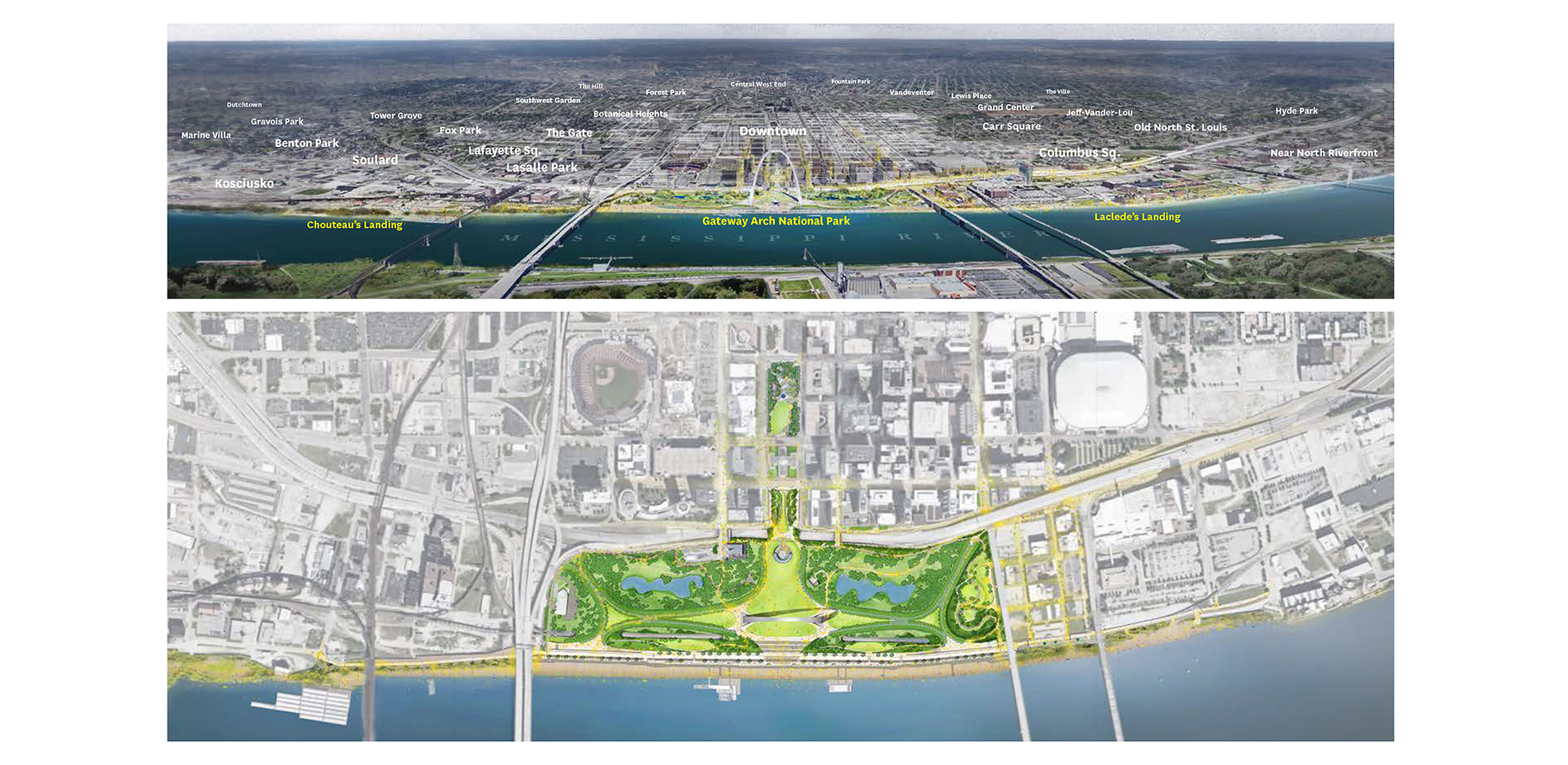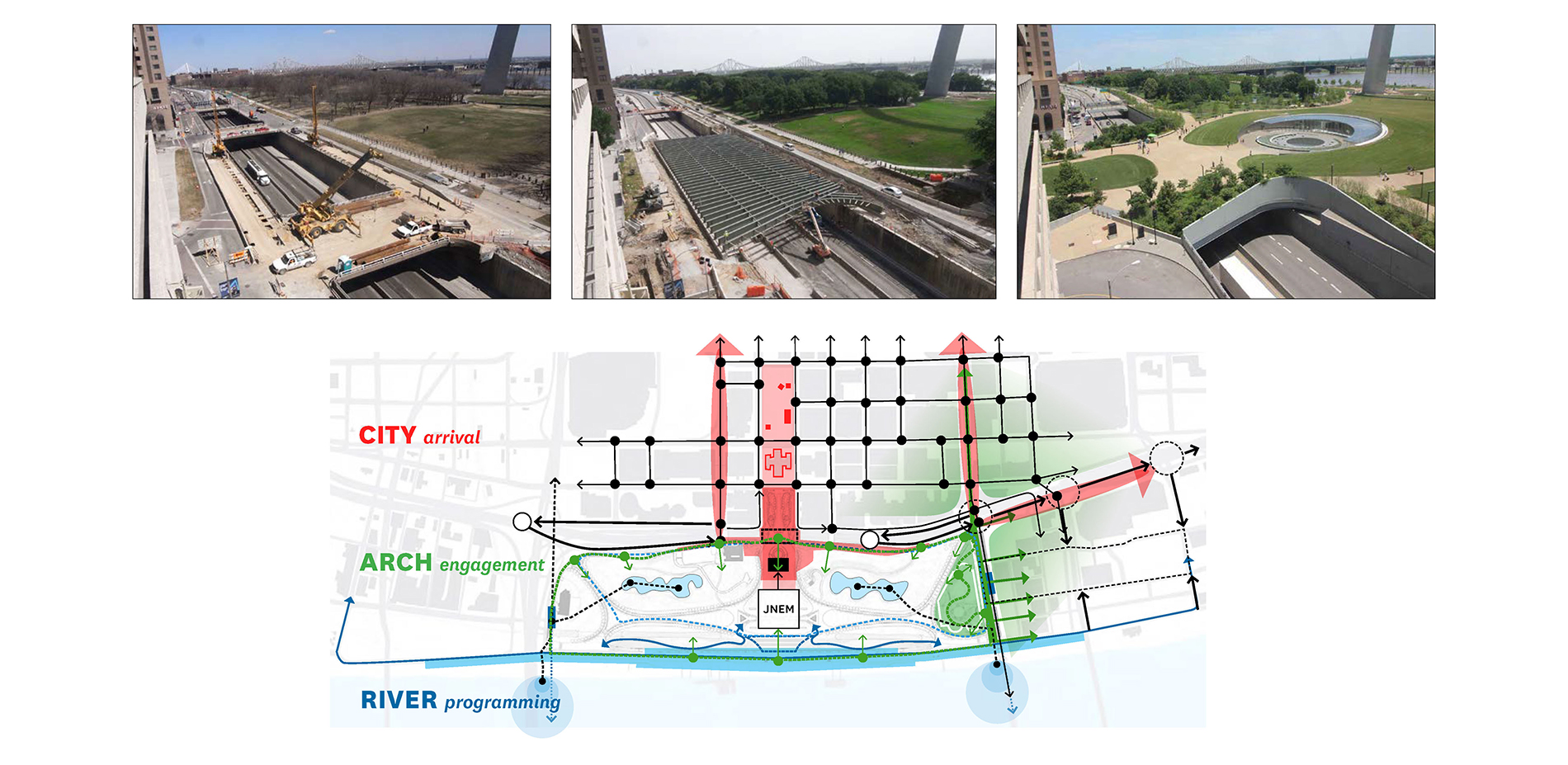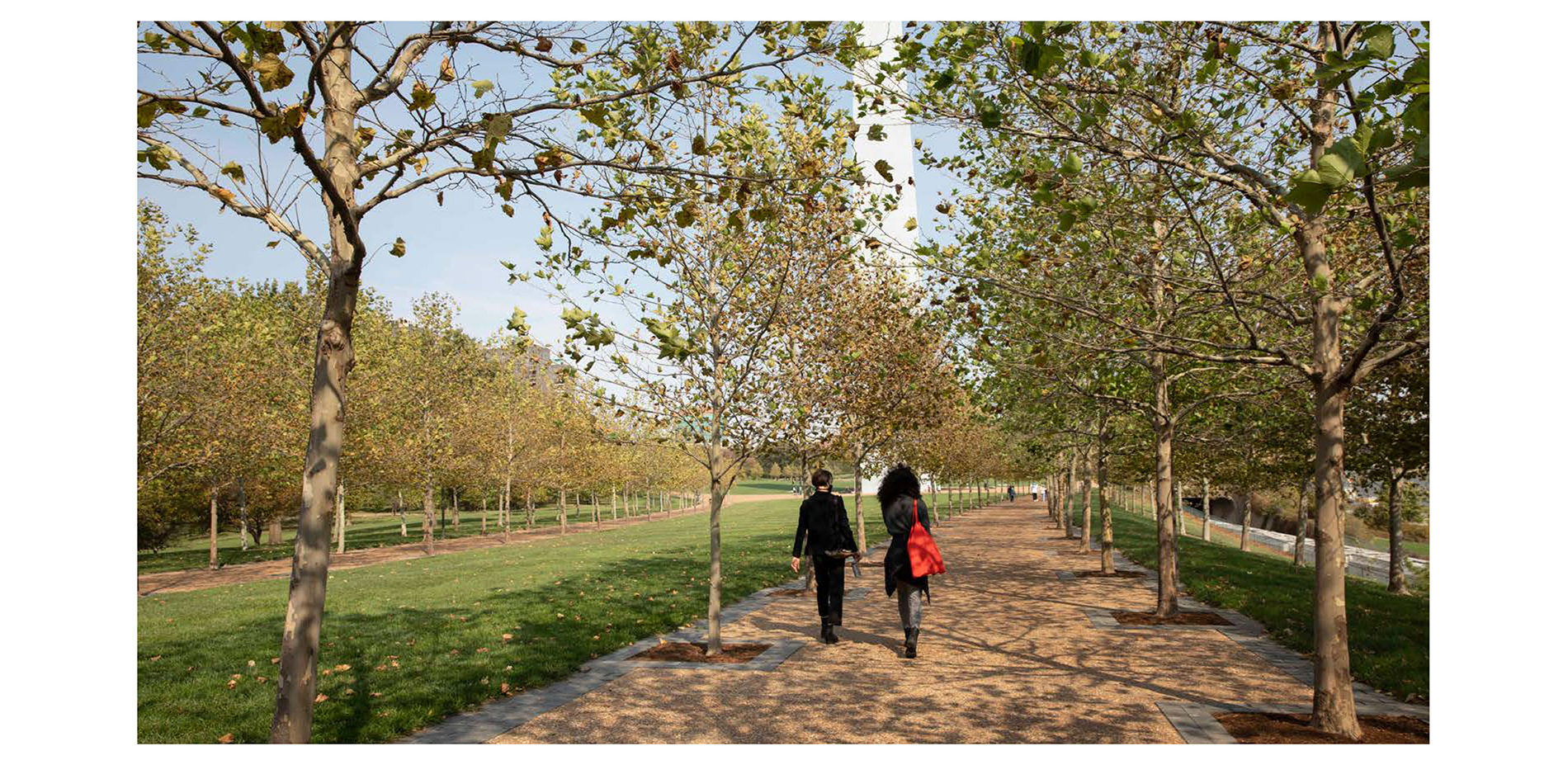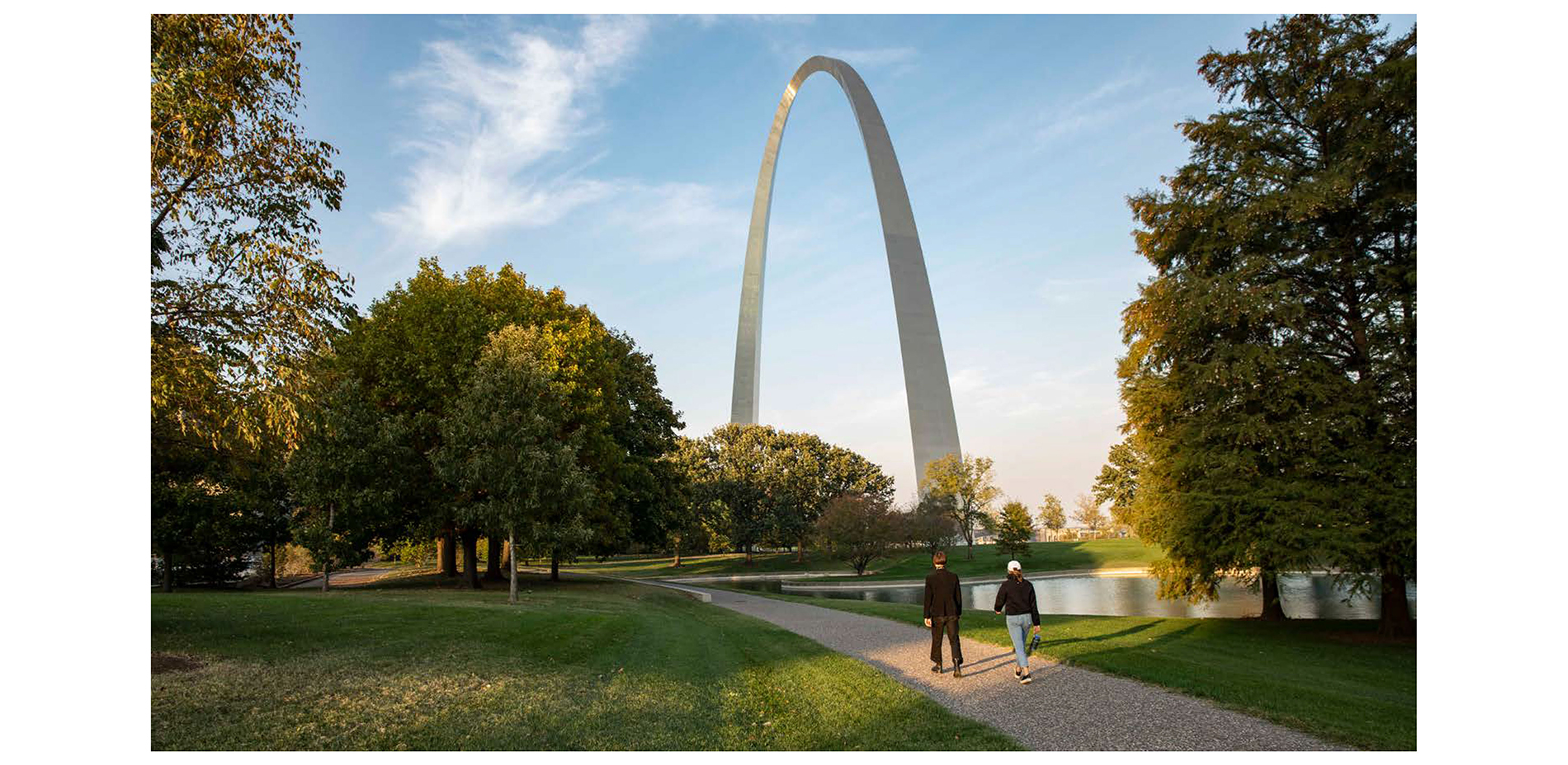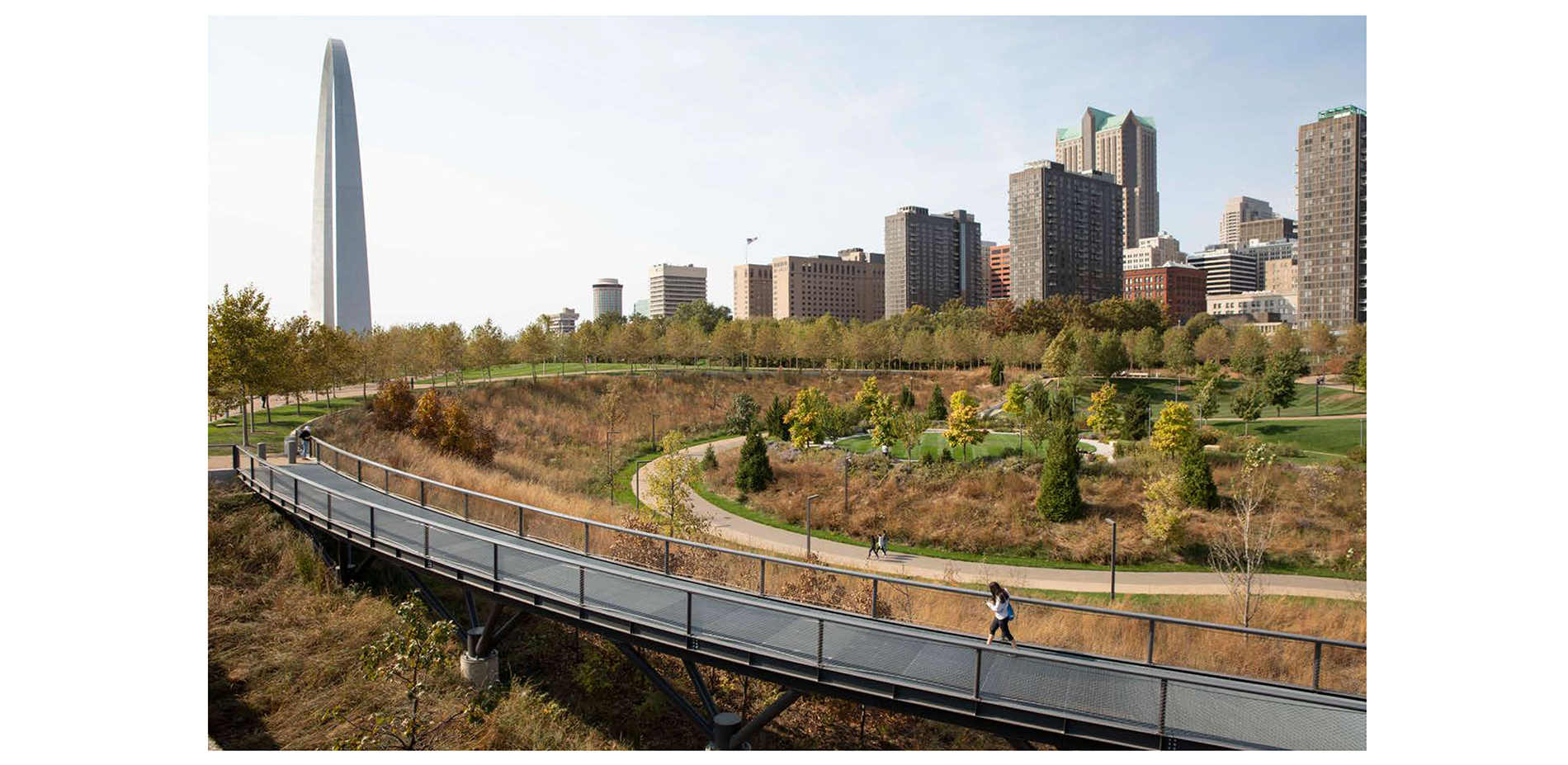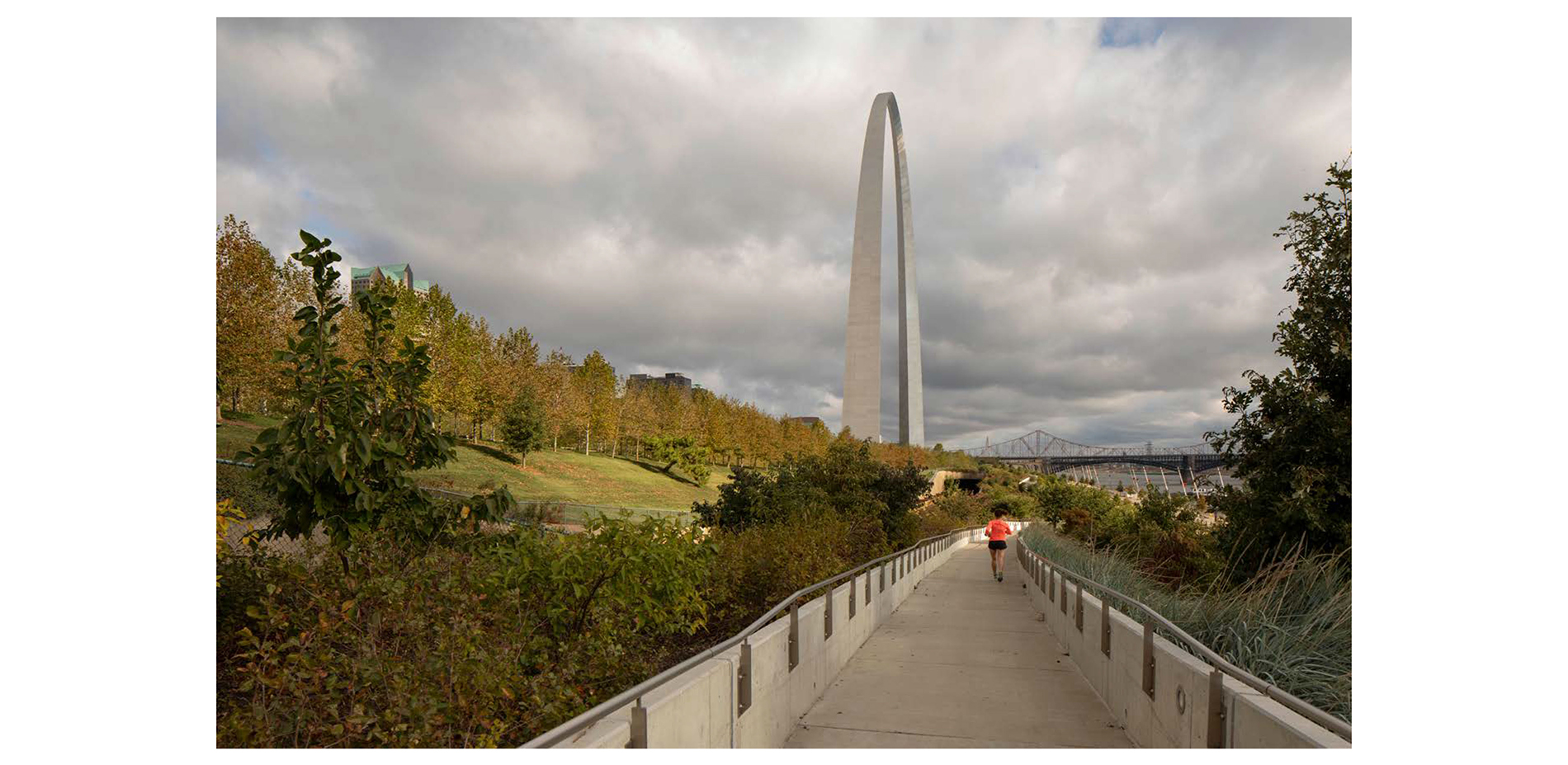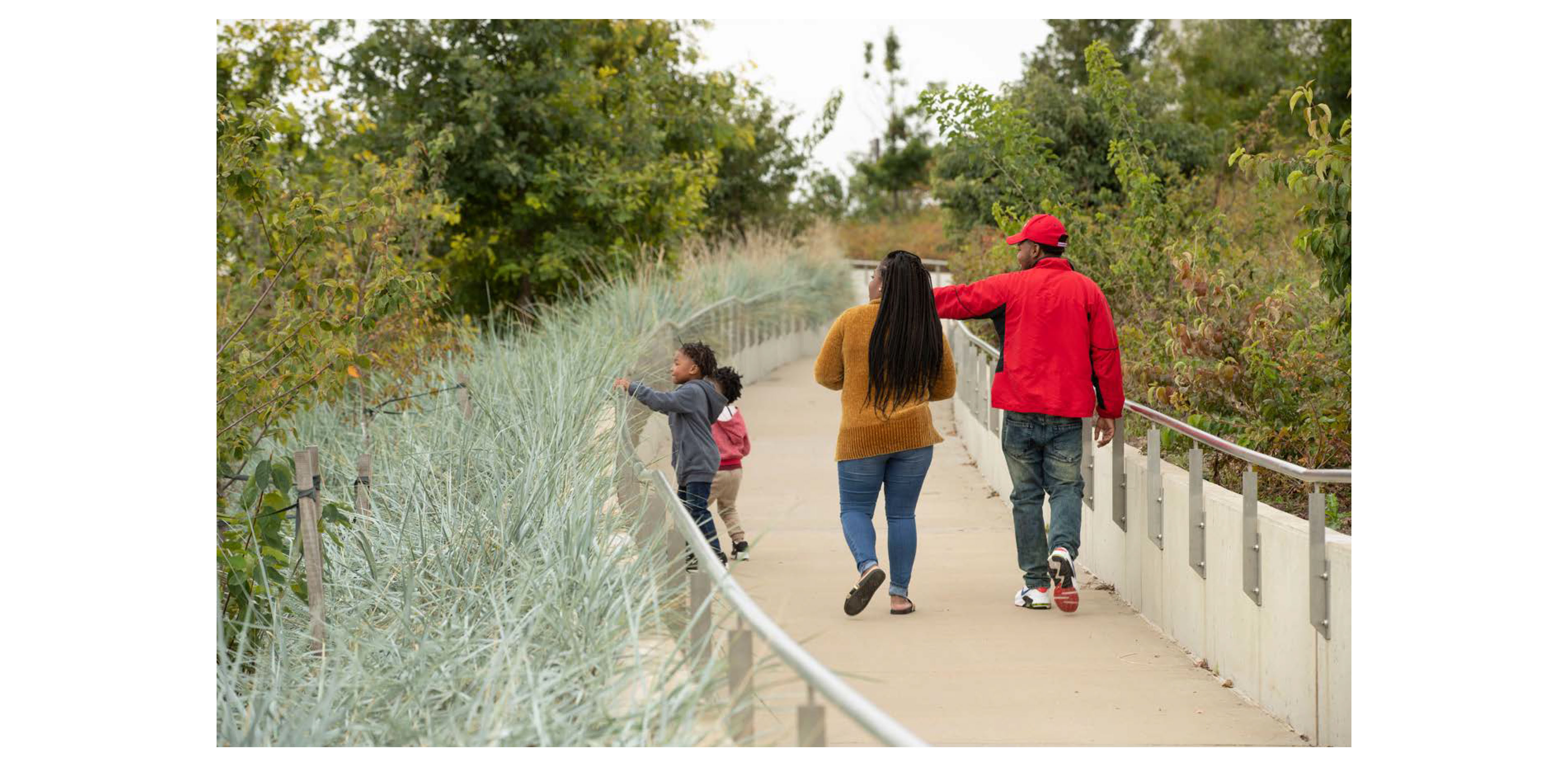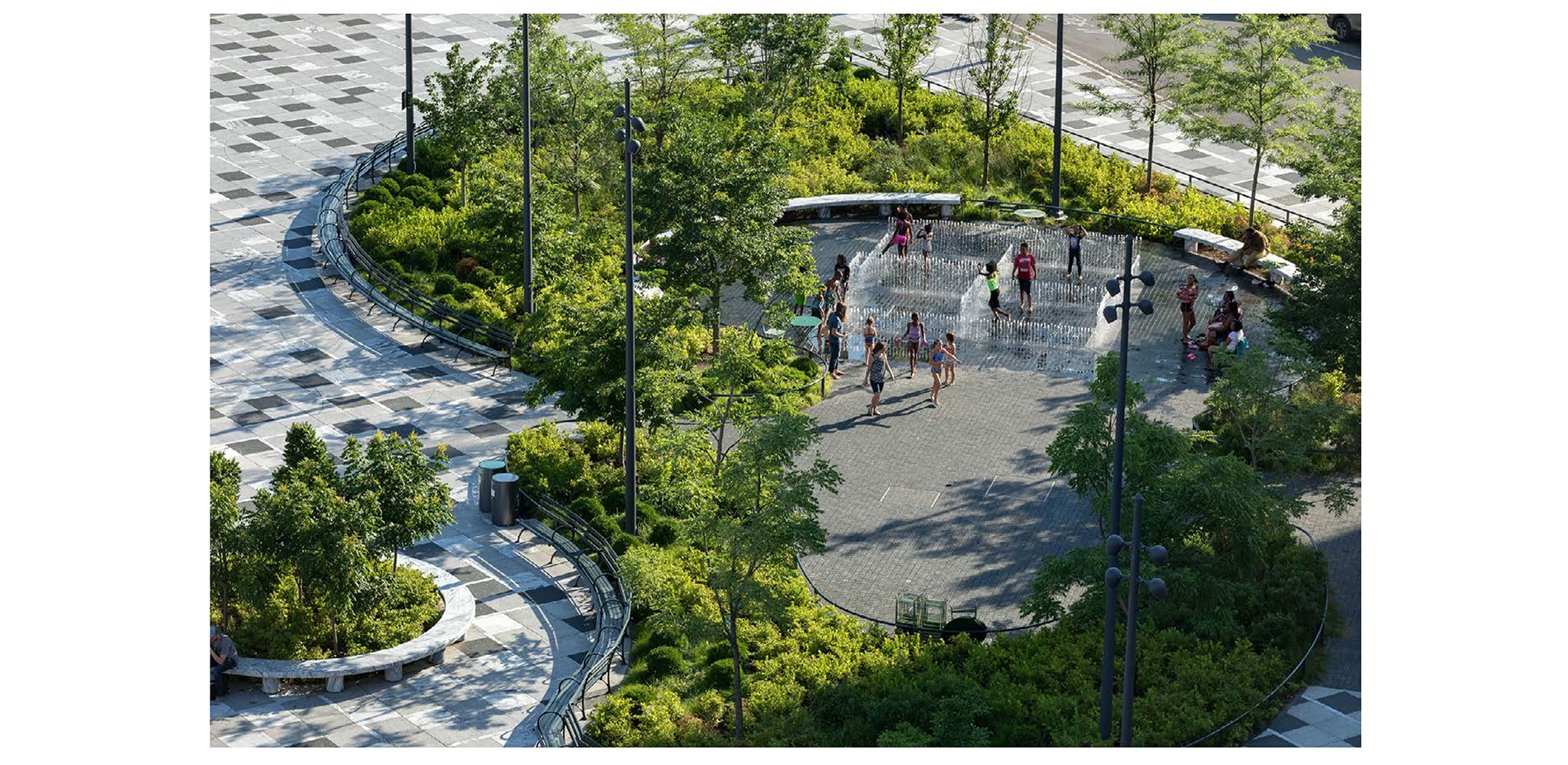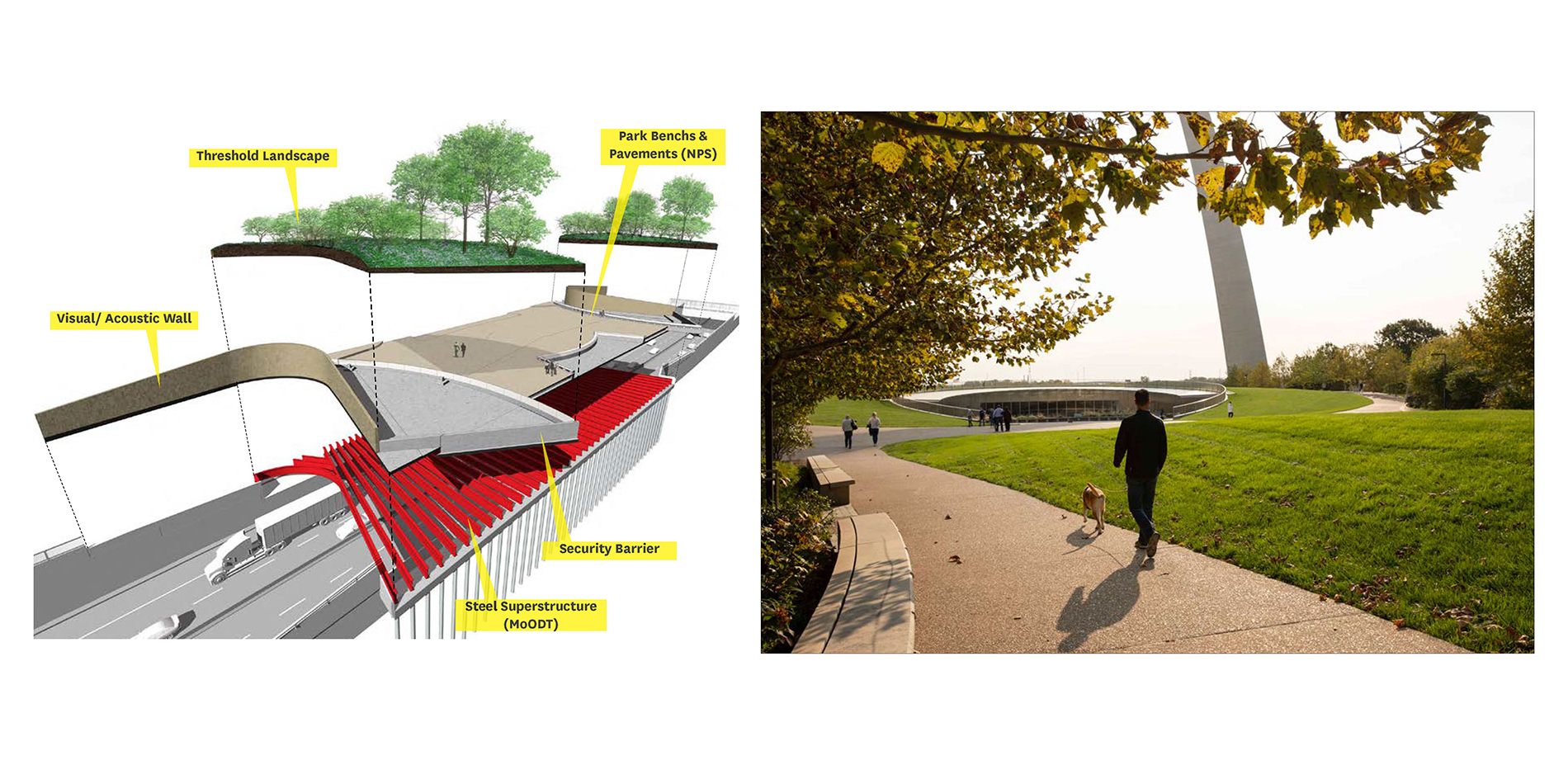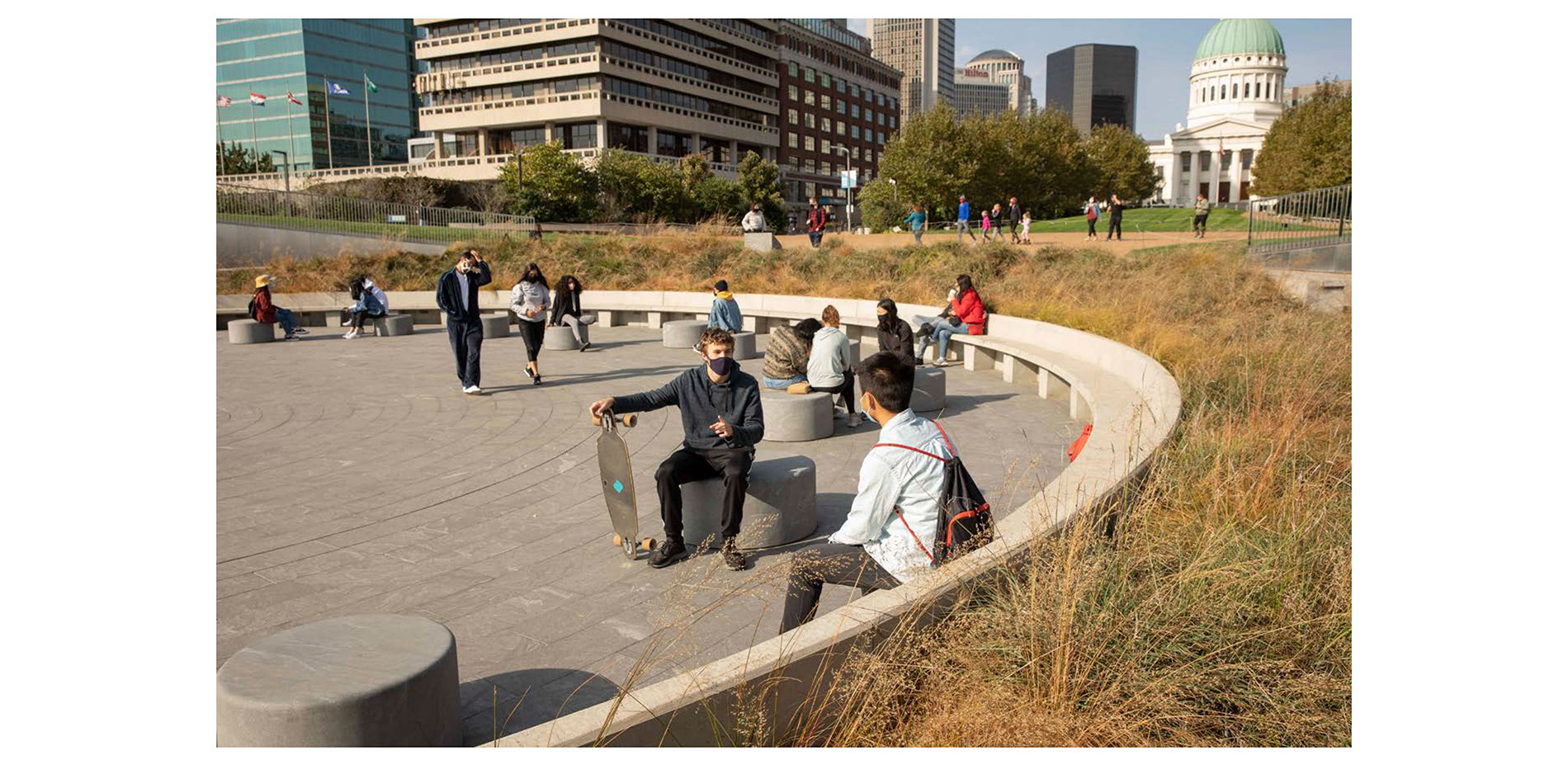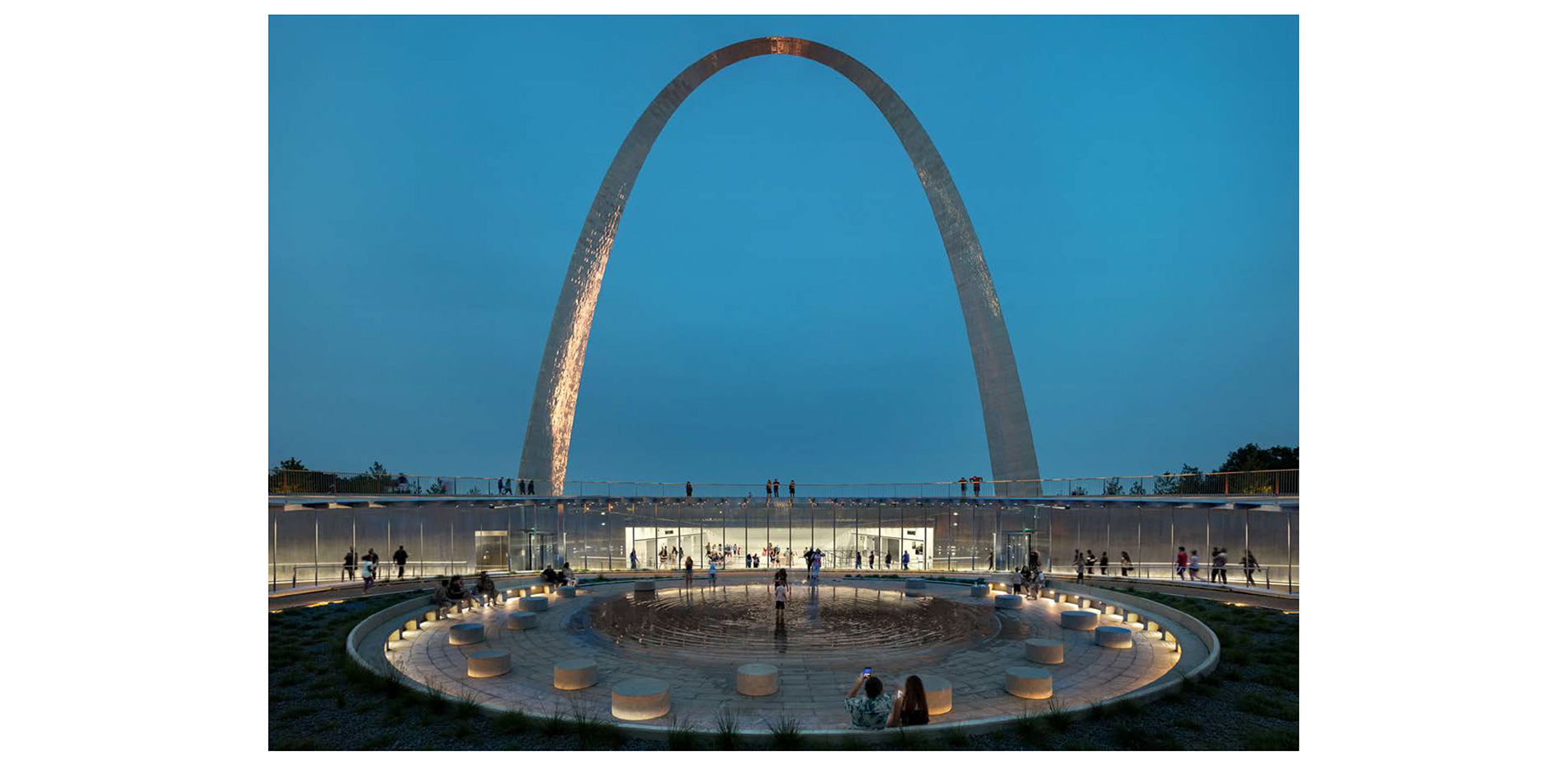The CityArchRiver Project
Honor Award
Urban Design
St. Louis, Missouri, United States
Michael Van Valkenburgh Associates
Client: Gateway Arch Park Foundation and the National Park Service
Although the St. Louis Arch is widely known and appreciated, for decades it has been isolated from the downtown St. Louis area by an Interstate highway, which prevented the Arch’s many visitors from filtering into the city’s businesses. A new land bridge caps a portion of the highway to the west of the Arch to form the key access to the Arch grounds, while additional points of entry at the north, south, and along the river’s edge to the east increase overall connectivity to the site. A considerate restoration of Dan Kiley’s 91-acre park beneath the arch implements unrealized portions of his landscape plan, such as light poles designed by Eero Saarinen.
- 2021 Awards Jury
Project Credits
Gullivar Shepard, Laura Solano, Nate Trevethan, Neil Budzinski, James Smith, Tzufen Liao, Chris Donohue, James Bennett, Luke Ness, Nicholas Pevzner, Michael Wilson, Nik Elkovitch, Adrienne Heflich, Alexia Friend, Tyler Krob, Tim Kirby, Yu Ding, MVVA Design and Construction Team
Applied Ecological Services, Inc., Ecological Design
Cohen Hilberry Architects, Accessibility and Urban Design
Civil Design, Inc., Site Stormwater Civil Engineering
David Mason & Associates, Site Civil/Structural Engineering - Arch Grounds and Riverfront
KJWW (now IMEG Corp.), Site Electrical/Mechanical/Engineering
Landtech Design, Irrigation
LimnoTech, Hydrology
Olsson Associates, Soil Science
Randy Burkett Lighting, Lighting Design
ABNA Engineering, Site Civil and Structural Engineering - Kiener Plaza
ABS Consulting, Site Security Consultant
EDSI, Surveyor
Hydro Dramatics, Fountain Design
Geotechnology, Inc., Geotechnical Engineer
Ecological Landscape Management, Ecological Arborist
Wahaso, Stormwater Harvesting
Cooper Robertson & Partners, Architecture and Urban Design - Museum
James Carpenter Design Associates, Inc., Architectural Design - Museum
Trivers Associates, Architecture - Old Court House
Project Statement
Working with the CityArchRiver Foundation, the National Park Service, Missouri DOT, Great Rivers Greenway, and several other governmental and community stakeholders, the landscape architect led a team of planners, engineers, and technical specialists to define and execute a project that would transform the Gateway Arch National Park into a vibrant urban nexus that reconnects downtown to the waterfront and its surrounding neighborhoods. The design addressed this complex site with an orchestrated mix of bold new infrastructure, historic restoration, and layered strategic improvements. Since the completion of the $380 million project in fall 2018, visits by both locals and visitors have surged, helping revitalize downtown St. Louis. This project also humanizes a legacy of grand design gestures and insensitive infrastructure development through multiple scales of problem-solving and creating ways for a national monument to contribute to the daily life of the local community while still fulfilling its legislated mission.
Project Narrative
Weaving a National Landmark Back into the Urban Context of St. Louis
Eero Saarinen’s Gateway Arch, conceived alongside the 91-acre grounds designed by Dan Kiley, is an unforgettable St. Louis landmark memorializing a nationally significant crossing point of the Mississippi River. Severed from downtown by an interstate highway introduced late in the original design process and with connectivity further weakened by decades of piecemeal planning, the Arch grounds did not live up to their promise as a center of public life. As the monument approached its 50th anniversary, The CityArchRiver Foundation commissioned a project to lay out a comprehensive urban design strategy to redefine and expand its role in the city and region.
The Foundation was formed in 2009 to bring together the Mississippi River and the Arch as national landmarks, and remedy the monument’s unfulfilled economic and social potential. In 2010, the landscape architects, leading a large team of consultants, won an international ideas competition with their proposal for how to reconnect the experience of downtown St. Louis, the Gateway Arch, and Mississippi River—while breathing new life and economic vitality into a downtown suffering from 5 decades of population and economic decline.
The design employed a myriad of tactical solutions to mitigate problematic infrastructure, poor urban connectivity, and a high-maintenance, under-performing landscape. Together, these solutions formed a unified strategy to accomplish the project’s overarching objective. The team worked with 30 federal, state, and city agencies, community groups, and countless other stakeholders to overcome the monument’s isolation. Key topics of early planning efforts included interstate transportation, multi-modal connectivity, sustainability and landscape resilience, water quality improvements in the Mississippi, the needs of the local business community, regional economic impact, accessibility, equity, and the prospect of democratizing the prominent site given its location within the federal jurisdiction.
When the I-70 highway was built just after the monument was finished, downtown St. Louis became completely cut off from the Arch grounds. The CityArchRiver team used traffic planning models to persuade transportation agencies to approve the reclamation of a significant portion of the National Parkland that intersected the Interstate right-of-way. The reinstatement of park sovereignty facilitated a new land bridge that spanned over the highway, integrating the existing park into a new downtown-facing museum entrance, and, at a broader scale, linking St. Louis’ Gateway Mall, to the Mississippi River. The new land bridge and museum entry transformed the experience of visiting the Arch by welcoming the visitor at the beginning of a visit, making the entire facility accessible for the first time, and creating a series of interior and exterior spaces along the axis of the Arch to support both local St. Louis cultural events in line with the mission of the National Park.
The project was funded through private and public sources, including a voter-supported sales tax and federal funding through a Transportation Investment Generating Economic Recovery (TIGER) Grant.
Rethinking Access to Support a More Inclusive Landscape
The primary entrance to the Arch grounds was a 1,600-car garage on the north side of the site which offered all too convenient access to and from the highway, bypassing most visitor interaction with downtown. As part of the CityArchRiver project, the garage was demolished and an incentive program was created to direct visitors to the many underutilized garages along the nearby Gateway Mall. The removal of the garage and the associated roadways created 9.3 acres of newly designed landscapes to invite visitors and locals alike to the grounds and offer new experiences at the edges of the site. The reclaimed area features a bowl-shaped lawn for musical performances and festivals and an Explorer’s Garden set against the backdrop of the Eads Bridge masonry previously concealed by the massive garage. A once-isolated neighborhood and light-rail station north of the monument is now accessible directly to and from the Arch grounds and the downtown core via a curved, 400-foot-long elevated walk.
Overall removal of the garage, improves transportation efficacy, pedestrian safety, bike networks, and casual and programmed activities for the surrounding communities—all of which strengthen the sense of a civic connection to the monument. The previously underutilized and hard-to-access Kiener Plaza, which is the westernmost open space in the Gateway Mall axis, was redesigned to provide a landing point for most visitors to the National Park, including a playground, cafe, lawn, and market space that serve as a draw for both tourists and locals.
A 16-foot-wide loop trail was inscribed into the edge of the site, decoupled from the adjacent roads improving pedestrian and bike connections between the downtown, the Arch grounds, and the Mississippi Riverfront. Replacing unapproachable street-edge sidewalks, a new trail meanders through the park landscape, and links to the new central bikeway on the Mississippi River that ties together multiple regional networks. The loop and network of pedestrian access work together to make accessibility the norm, rather than the exception.
Environmental Sustainability and Landscape Resilience
The project navigated historic preservation parameters defined by the NPS and contemporary goals for ecological resilience. Over 800 ash trees, vulnerable to the Emerald Ash Borer, were replaced with more resilient London Plane trees and an additional 3,000 new trees were planted on site. New meadows and bioswales improved habitat and stormwater management while honoring the original design intent. Shallow sinuous ponds, originally designed by Kiley and Saarinen, were re-engineered to eliminate green algae plumes resulting from nutrient loading. A soils improvement program utilized radish and rye cover crop techniques from agricultural science to address severe soil compaction, restore resilient nutrient cycles in the soil biology, increase moisture holding capacity, and reduce irrigation demand.
Just above with the Mississippi River, the project provides flood protection for a 1.6-mile urban arterial that runs along the foot of the Arch grounds. Prior to the modifications achieved through the project, the roadway flooded frequently, restricting access and limiting economic viability. By elevating the waterfront promenade and creating a flexible “river fender” system to allow for simpler cleanup operations after severe flood events, the project reduces shutdowns, creates a new promenade, and supports the growth of the regional bike networks along the Missouri and Mississippi Rivers.
Contribution of Project to a Broader Urban Framework
CityArchRiver’s strength lies in its ensemble of achievements. The waterfront hosts businesses and cultural events that had all but disappeared but are now flood protected and enhanced by a linear mile of roadway improvements. The project has also bolstered a wave of new investment in the downtown core—a new museum, commercial and retail buildings, infill retail, and the first multilevel residential development, all within a few blocks of the monument. The National Park, previously considered an island isolated in the midst of downtown St. Louis, has become host to many new community events, both programmed and spontaneous. By deploying urban design strategies that aggregate possibilities, mediate obstacles, foster cooperative agreements between city, state, and federal agencies, and prioritize key community-motivated programming changes, the CityArchRiver project has helped unlock more equitable social use, improved environmental performance, and economic potential for downtown St. Louis and its signature National Park.
Products
-
Furniture
- Bike Rack- Anova
- Trash/Recycle- Landscape Forms
- Drinking Fountains- Elkay
- Worlds Fair Bench at Kiener Plaza- Kenneth Lynch and Sons, Inc.
- Custom Marble Bench at Kiener Plaza- Polycor
-
Fences/Gates/Walls
- Playgarden Fence and Gate at Kiener Plaza- Custom with Carl Stahl mesh infill
-
Irrigation
- Rain Bird
-
Parks/Recreation Equipment
- Kiener Plaza Playgraden- Climber, swing, slide, rockers: Richter Spielgerate GMBH
-
Structures
- Metal Grating and Bridge Walkway and Fountains- Hendrick Architectural Products
-
Hardscape
- Granite Pavers, Sets, and Curbs at Kiener Plaza- Polycor
- Marble Pavers at Kiener Plaza- PolycorPrecast Concrete Pavers at Kiener Plaza- Wasusa Tile
- Tactile Warning- Neenah
- Safety Surface- DuraPlay Safety Surfaces, Inc.
-
Lighting
- Kiener Plaza Lighting- Bega, Selux, Philips, Tokistar , and GE
Plant List
- American Hornbeam
- American Sentry Linden
- Autumn Brilliance Serviceberry
- Bald Cypress
- Bloodgood London Planetree
- Bur Oak
- Chinkapin Oak
- Common Hackberry
- Emerald Sentinel Eastern Red Cedar
- Espresso Kentucky Coffee Tree
- Exclamation London Planetree
- Fringe Tree
- Galaxy Magnolia
- Hop Hornbeam
- Jane Magnolia
- Jane Magnolia
- Loebner Magnolia
- Northern Catalpa
- Nutalls Oak
- Overcup Oak
- Pawpaw
- Red Buckeye
- Redbud
- Roughleaf Dogwood
- Sassafras
- Shagbark Hickory
- Shingle Oak
- Shumard Oak
- Siouxland Cottonwood
- Sugar Hackberry
